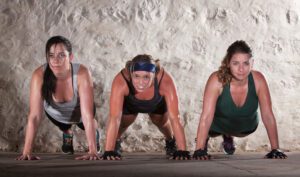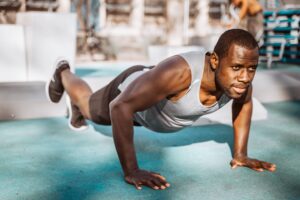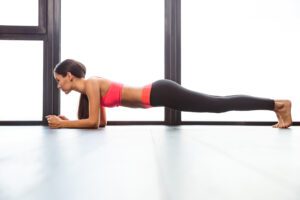Martial arts demand a combination of strength, speed, and agility, with the upper body playing a pivotal role in executing powerful strikes and maintaining effective defensive postures. Among the various exercises that contribute to martial arts conditioning, push-ups stand out as a fundamental yet highly effective method for building upper body power. In this blog post, we’ll delve into the importance of push-ups in martial arts training, explore specific benefits, and provide a comprehensive guide on incorporating push-ups into your martial arts fitness routine.
The Significance of Push-Ups in Martial Arts:
- Upper Body Strength:
- Push-ups primarily target the chest, shoulders, and triceps – key muscle groups essential for generating force in punches, blocks, and grappling movements.
- Stabilization and Control:
- The core engagement required during push-ups enhances stability and control, crucial for maintaining balance and executing precise martial arts techniques.
- Endurance Building:
- Martial arts bouts can be physically demanding, requiring sustained effort. Push-ups, especially when performed in sets with minimal rest, contribute to building endurance in the upper body.
- Versatility:
- Push-ups offer numerous variations that can target different muscle groups. This versatility allows martial artists to tailor their training to specific needs, whether it’s enhancing punching power or improving defensive maneuvers.
Benefits of Push-Ups for Martial Arts:
- Increased Striking Power:
- The explosive force generated during push-ups translates directly to increased striking power. Strong chest and shoulder muscles contribute to powerful punches and effective strikes.
- Enhanced Blocking and Defending:
- The stability and control developed through push-ups improve a martial artist’s ability to block and defend against opponents. A strong and stable upper body is better equipped to withstand and counteract incoming attacks.
- Core Strength for Ground Techniques:
- Many martial arts disciplines involve ground techniques and grappling. The core engagement in push-ups contributes to overall core strength, facilitating better performance in ground-based movements.
- Improved Arm Endurance:
- The repetitive nature of push-ups builds endurance in the arms, allowing martial artists to maintain a high level of performance throughout training sessions and competitions.
Incorporating Push-Ups into Your Martial Arts Training:
- Structured Warm-Up:
- Begin your martial arts training session with a structured warm-up that includes dynamic movements and joint mobility exercises. Incorporate a set of standard push-ups to activate the upper body.
- Push-Up Variations:
- Explore different push-up variations to target specific areas. Include wide-grip push-ups for enhanced chest engagement, close-grip push-ups for triceps strength, and decline push-ups for a more challenging workout.
- Circuit Training:
- Integrate push-ups into circuit training routines. Combine them with martial arts-specific drills such as shadowboxing, kicks, and footwork exercises to create a well-rounded workout.
- Timed Sets:
- Train for endurance by incorporating timed push-up sets into your routine. Perform as many quality push-ups as possible within a set time frame, gradually increasing the duration as your endurance improves.
- Balance with Lower Body Training:
- While push-ups focus on the upper body, it’s crucial to maintain balance in your training. Incorporate lower body exercises such as squats, lunges, and kicks to ensure overall strength and agility.
- Mindful Execution:
- Pay attention to proper form during push-ups. Maintain a straight line from head to heels, engage the core, and focus on controlled movements. Quality repetitions are more beneficial than quantity.
Push-Up Variations for Martial Arts Conditioning:
- Standard Push-Ups:
- Targets overall upper body strength and endurance.
- Wide Grip Push-Ups:
- Emphasizes the outer chest and shoulders, contributing to increased striking power.
- Close Grip Push-Ups:
- Focuses on triceps strength, beneficial for executing fast and powerful punches.
- Explosive Plyometric Push-Ups:
- Enhances explosive power, crucial for rapid strikes and defensive movements.
- One-Arm Push-Ups:
- Builds unilateral strength and stability, beneficial for asymmetrical movements in martial arts.
- Decline Push-Ups:
- Engages the lower chest and triceps, contributing to well-rounded upper body strength.
Tips for Effective Push-Up Training in Martial Arts:
- Consistency is Key:
- Incorporate push-ups into your training routine consistently. Aim for at least three sessions per week to see improvements in strength and endurance.
- Focus on Form:
- Prioritize proper form over the number of repetitions. Maintain a strong mind-muscle connection and execute each push-up with precision.
- Gradual Progression:
- Gradually increase the intensity of your push-up workouts. Progress from standard push-ups to more challenging variations as your strength improves.
- Integrate into Skill Training:
- Incorporate push-ups into specific skill training sessions. For example, perform push-ups followed by striking drills to simulate the physical demands of a martial arts bout.
- Combine with Flexibility Training:
- Martial arts require a combination of strength and flexibility. Pair push-up training with flexibility exercises to ensure a well-rounded approach to martial arts conditioning.
Conclusion:
Push-ups, when integrated strategically into your martial arts training, can significantly contribute to the development of upper body power, endurance, and stability. By incorporating a variety of push-up variations and maintaining a consistent training routine, martial artists can enhance their overall performance in striking, blocking, and grappling techniques. As you embark on your push-up journey for martial arts conditioning, remember that each repetition brings you closer to unleashing the full potential of your upper body strength in the dojo or the ring.



